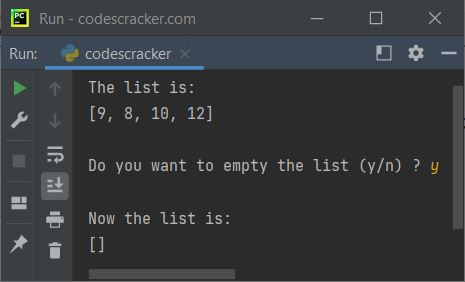- Python Built-in Functions
- Python All Built-in Functions
- Python print() Function
- Python input() Function
- Python int() Function
- Python float() Function
- Python len() Function
- Python range() Function
- Python str() Function
- Python ord() Function
- Python chr() Function
- Python ascii() Function
- Python pow() Function
- Python type() Function
- Python List Functions
- Python list() Function
- Python insert() Function
- Python append() Function
- Python extend() Function
- Python pop() Function
- Python remove() Function
- Python reverse() Function
- Python sort() Function
- Python sorted() Function
- Python Dictionary Functions
- Python dict() Function
- Python update() Function
- Python get() Function
- Python keys() Function
- Python setdefault() Function
- Python fromkeys() Function
- Python items() Function
- Python popitem() Function
- Python Tuple Function
- Python tuple() Function
- Python Set Functions
- Python set() Function
- Python frozenset() Function
- Python String Functions
- Python split() Function
- Python join() Function
- Python format() Function
- Python replace() Function
- Python Iterator Functions
- Python iter() Function
- Python min() Function
- Python max() Function
- Python sum() Function
- Python count() Function
- Python index() Function
- Python copy() Function
- Python clear() Function
- Python next() Function
- Python filter() Function
- Python enumerate() Function
- Python zip() Function
- Python reversed() Function
- Python Number Functions
- Python abs() Function
- Python bin() Function
- Python oct() Function
- Python hex() Function
- Python round() Function
- Python divmod() Function
- Python complex() Function
- Python File Handling Functions
- Python open() Function
- Python read() Function
- Python readable() Function
- Python readline() Function
- Python readlines() Function
- Python write() Function
- Python writable() Function
- Python writelines() Function
- Python close() Function
- Python seek() Function
- Python tell() Function
- Python flush() Function
- Python fileno() Function
- Python truncate() Function
- Python Class Functions
- Python object() Function
- Python property() Function
- Python getattr() Function
- Python setattr() Function
- Python hasattr() Function
- Python delattr() Function
- Python classmethod() Function
- Python staticmethod() Function
- Python issubclass() Function
- Python super() Function
- Python Misc Functions
- Python all() Function
- Python any() Function
- Python isatty() Function
- Python bool() Function
- Python callable() Function
- Python globals() Function
- Python locals() Function
- Python dir() Function
- Python id() Function
- Python isinstance() Function
- Python map() Function
- Python repr() Function
- Python slice() Function
- Python vars() Function
- Python Advance Functions
- Python help() Function
- Python hash() Function
- Python breakpoint() Function
- Python bytes() Function
- Python bytearray() Function
- Python memoryview() Function
- Python compile() Function
- Python eval() Function
- Python exec() Function
- Python Tutorial
- Python Tutorial
- Python Examples
- Python Examples
Python clear() Function
The clear() function in Python is used to empty the list, dictionary, or set. That is, the clear() function removes all items from the list, dictionary, or set. For example:
mylist = [9, 8, 10, 12] print("The list is:") print(mylist) mylist.clear() print("\nNow the list is:") print(mylist)
The output produced by above Python code, demonstrating the clear() function, is:
The list is: [9, 8, 10, 12] Now the list is: []
The list exists, but becomes empty. Here is another example of clear() function. In this example, I've used this function to remove all items of the dictionary:
mydictionary = {"Name": "Mathew", "City": "California"}
print("The dictionary is:")
print(mydictionary)
mydictionary.clear()
print("\nNow the dictionary is:")
print(mydictionary)
The output produced by this program will exactly be:
The dictionary is:
{'Name': 'Mathew', 'City': 'California'}
Now the dictionary is:
{}
Same things goes with the set. Here is an example, uses clear() function to empty the set, or to remove all elements of a set:
myset = {1, 2, 3}
print(myset)
myset.clear()
print(myset)
The output produced by this Python program, is given below:
{1, 2, 3}
set()
Python clear() Function Syntax
Syntax to use clear() function in Python is:
variableName.clear()
Python clear() Function Example
Here is another example of clear() function in Python, that empty the list if user wants:
mylist = [9, 8, 10, 12] print("The list is:") print(mylist) print("\nDo you want to empty the list (y/n) ? ", end="") choice = input() if choice == 'y': mylist.clear() print("\nNow the list is:") print(mylist) else: print("\nOk!")
The snapshot given below shows the sample run of above Python code, with user input y as choice to empty the list named mylist:

« Previous Function Next Function »